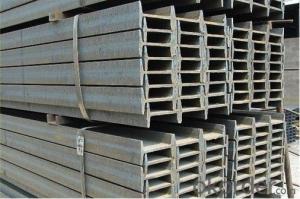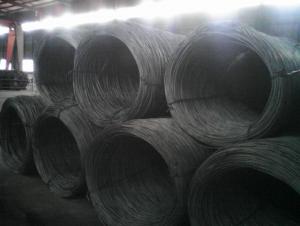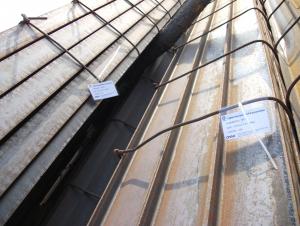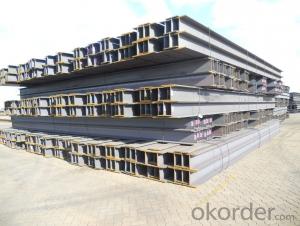Steel H Beam Hot Rolled High Quality 100-900MM
- Loading Port:
- China main port
- Payment Terms:
- TT OR LC
- Min Order Qty:
- 50 m.t.
- Supply Capability:
- 10000 m.t./month
OKorder Service Pledge
OKorder Financial Service
You Might Also Like
Specification
Steel H Beam Hot Rolled High Quality 100MM-900MM
Product Applications:
H Beam Hot Rolled High Quality 100MM-900MM are ideal for structural applications and are widely used in the construction of buildings and bridges, and the manufacturing, petrochemical, and transportation industries.
Product Advantages:
OKorder's H Beam Hot Rolled High Quality 100MM-900MM are durable, strong, and resist corrosion.
Main Product Features:
· Premium quality
· Prompt delivery & seaworthy packing (30 days after receiving deposit)
· Corrosion resistance
· Can be recycled and reused
· Mill test certification
· Professional Service
· Competitive pricing
Product Specifications:
Manufacture: Hot rolled
Grade: Q195 – 235
Certificates: ISO, SGS, BV, CIQ
Length: 6m – 12m, as per customer request
Packaging: Export packing, nude packing, bundled
Chinese Standard (H*W*T) | Weight (Kg/m) | 6m (pcs/ton) | Light I (H*W*T) | Weight (Kg/m) | 6m (pcs/ton) | Light II (H*W*T) | Weight (Kg/m) | 6M |
100*68*4.5 | 11.261 | 14.8 | 100*66*4.3 | 10.13 | 16.4 | 100*64*4 | 8.45 | 19.7 |
120*74*5.0 | 13.987 | 11.9 | 120*72*4.8 | 12.59 | 13.2 | 120*70*4.5 | 10.49 | 15.8 |
140*80*5.5 | 16.89 | 9.8 | 140*78*5.3 | 15.2 | 10.9 | 140*76*5 | 12.67 | 13.1 |
160*88*6 | 20.513 | 8.1 | 160*86*5.8 | 18.46 | 9 | 160*84*5.5 | 15.38 | 10.8 |
180*94*6.5 | 24.143 | 6.9 | 180*92*6.3 | 21.73 | 7.6 | 180*90*6 | 18.11 | 9.2 |
200*100*7 | 27.929 | 5.9 | 200*98*6.8 | 25.14 | 6.6 | 200*96*6.5 | 20.95 | 7.9 |
220*110*7.5 | 33.07 | 5 | 220*108*7.3 | 29.76 | 5.6 | 220*106*7 | 24.8 | 6.7 |
250*116*8 | 38.105 | 4.3 | 250*114*7.8 | 34.29 | 4.8 | 250*112*7.5 | 28.58 | 5.8 |
280*122*8.5 | 43.492 | 3.8 | 280*120*8.2 | 39.14 | 4.2 | 280*120*8 | 36.97 | 4.5 |
300*126*9 | 48.084 | 3.4 | 300*124*9.2 | 43.28 | 3.8 | 300*124*8.5 | 40.87 | 4 |
320*130*9.5 | 52.717 | 3.1 | 320*127*9.2 | 48.5 | 3.4 | |||
360*136*10 | 60.037 | 2.7 | 360*132*9.5 | 55.23 | 3 |

- Q: How do steel H-beams contribute to the overall sustainability of a structure?
- Steel H-beams contribute to the overall sustainability of a structure in several ways. Firstly, steel is a highly durable material with a long lifespan, reducing the need for frequent replacements or repairs. This increases the longevity of the structure and minimizes waste generation. Additionally, steel is a recyclable material, meaning that H-beams can be easily repurposed or recycled at the end of their life cycle, reducing environmental impact. Moreover, steel H-beams have a high strength-to-weight ratio, allowing for lighter and more efficient designs, which can result in reduced energy consumption during construction and operation. Overall, the use of steel H-beams promotes sustainable practices by offering durability, recyclability, and energy efficiency in structural design.
- Q: How are steel H-beams used in industrial warehouses?
- Steel H-beams are commonly used in industrial warehouses as structural support beams. They provide strength and stability to the building, allowing for larger open spaces without the need for additional columns or supports. H-beams also facilitate the construction of multi-level storage systems, mezzanines, and overhead cranes, maximizing the usable space within the warehouse. Additionally, they are often used for framing walls, roofs, and floors, ensuring the overall structural integrity of the warehouse.
- Q: Can steel H-beams be used in hotel and resort construction?
- Indeed, hotel and resort construction can utilize steel H-beams. The construction industry commonly employs steel H-beams due to their strength, durability, and versatility. They serve as a dependable and stable structural support system, making them suitable for various applications in hotel and resort projects of a large scale. Steel H-beams bring forth numerous advantages in hotel and resort construction. Firstly, their ability to bear heavy loads makes them perfect for supporting multiple floors, walls, and other building components. This enables the construction of spacious and expansive structures, which are often desired in hotel and resort endeavors. Furthermore, steel H-beams boast the capacity to span longer distances compared to alternative construction materials, thus reducing the need for additional support columns or walls. This design concept of an open floor plan is often favored in hotels and resorts as it creates generous and adaptable spaces for amenities like restaurants, conference rooms, and recreational areas. Another benefit of employing steel H-beams is their resistance to fire, pests, and natural disasters. Steel is non-combustible, thus providing an extra layer of safety in hotel and resort construction. Additionally, steel is impervious to termites or other pests, which may pose a threat in certain locations. Moreover, steel is renowned for its ability to withstand earthquakes, hurricanes, and other natural calamities, making it a reliable choice for hotel and resort projects situated in high-risk areas. To conclude, steel H-beams are undoubtedly suitable for hotel and resort construction. Their strength, durability, versatility, and resistance to fire and natural disasters make them an ideal option for creating secure, expansive, and open structures in the hospitality industry.
- Q: Can steel H-beams be used for pedestrian bridges?
- Steel H-beams are indeed suitable for pedestrian bridges. Due to their structural strength and stability, they are commonly utilized in construction projects. These beams are engineered to withstand heavy loads and offer exceptional support, making them a perfect fit for bridges. Even though pedestrian bridges typically bear lighter loads compared to those for vehicles, they still necessitate a sturdy and long-lasting structure to ensure safety. By using steel H-beams, a robust framework can be established for pedestrian bridges, providing a secure and stable pathway for pedestrians. Furthermore, steel exhibits high resistance to environmental factors like corrosion, which is particularly crucial for bridges exposed to outdoor elements. Hence, steel H-beams present a fitting choice for the construction of pedestrian bridges.
- Q: What are the different grades of steel used for manufacturing H-beams?
- The different grades of steel commonly used for manufacturing H-beams include A36, A572, A992, and A588.
- Q: Are steel H-beams suitable for high-rise buildings?
- Steel H-beams are well-suited for high-rise buildings. They possess several advantages that make them an excellent option for constructing tall structures. Firstly, their high strength-to-weight ratio allows for the creation of lighter and more efficient buildings. This is crucial in high-rise construction, where minimizing the weight of the structure is essential to reduce the load on the foundation and enhance overall stability. Secondly, steel H-beams exhibit exceptional load-bearing capacity, which is necessary for supporting the weight of multiple floors and withstanding external forces like wind, earthquakes, and more. The inherent strength and rigidity of steel enable the construction of tall buildings that can withstand these forces without compromising stability or safety. Moreover, steel H-beams offer greater flexibility in terms of design and construction. Their versatility empowers architects and engineers to create innovative and intricate structures, maximizing floor space and producing visually appealing designs. The ease of connecting and joining steel H-beams also facilitates faster construction, reducing project timelines. Furthermore, steel is a highly durable and long-lasting material. It resists corrosion, fire, and pests, making it an ideal choice for high-rise buildings with long lifespans. Steel H-beams also require minimal maintenance, which is advantageous in terms of cost and convenience. In conclusion, steel H-beams are indeed suitable for high-rise buildings due to their high strength, load-bearing capacity, flexibility in design, and durability. These factors position steel H-beams as the preferred choice for architects, engineers, and construction professionals when constructing tall buildings.
- Q: Are steel H-beams suitable for solar panel mounting structures?
- Yes, steel H-beams are suitable for solar panel mounting structures. They offer excellent strength and durability, making them an ideal choice for supporting the weight of solar panels. Additionally, steel H-beams can withstand various weather conditions, providing stability and longevity to the solar panel installation.
- Q: Can steel H-beams be used for residential construction?
- Yes, steel H-beams can be used for residential construction. They are commonly used in the construction of residential buildings and provide structural strength and stability. Steel H-beams offer several advantages such as durability, versatility, and the ability to support heavy loads, making them suitable for various residential construction applications.
- Q: How do steel H-beams perform in areas with high heat or thermal expansion?
- Steel H-beams perform well in areas with high heat or thermal expansion due to their excellent thermal conductivity and ability to withstand high temperatures without significant deformation. The structural integrity and dimensional stability of steel make it a reliable choice for such environments, as it can effectively dissipate heat and resist thermal expansion, ensuring the structural integrity of the H-beams.
- Q: How do steel H-beams contribute to the flexibility of architectural designs?
- Steel H-beams contribute to the flexibility of architectural designs in several ways. First and foremost, their structural properties allow for the creation of large, open spaces without the need for intermediate support columns or walls. This opens up possibilities for innovative and creative designs, as architects have more freedom to explore different layouts and configurations. Another way steel H-beams contribute to flexibility is through their strength and load-bearing capabilities. These beams can support heavy loads, which means architects can design structures with larger spans and higher ceilings. This is particularly useful in areas where space is limited or where a building needs to accommodate specific functions, such as warehouses, exhibition halls, or sports arenas. Furthermore, steel H-beams are highly durable and resistant to deformation, making them ideal for withstanding extreme weather conditions, earthquakes, or other natural disasters. This durability ensures the longevity of architectural designs and reduces maintenance costs over time. In addition to their structural benefits, steel H-beams also offer flexibility in terms of aesthetics. These beams can be exposed and integrated into a building's design, creating a modern and industrial look. Alternatively, they can be concealed within walls or floors, allowing for a more traditional or minimalist appearance. This versatility in design options allows architects to adapt the visual style to meet the specific requirements or preferences of their clients. Overall, steel H-beams contribute to the flexibility of architectural designs by providing structural integrity, enabling larger and more open spaces, offering durability and resistance to external forces, and allowing for various aesthetic choices. Their presence in construction projects allows architects to push the boundaries of design and create unique and innovative structures.
Send your message to us
Steel H Beam Hot Rolled High Quality 100-900MM
- Loading Port:
- China main port
- Payment Terms:
- TT OR LC
- Min Order Qty:
- 50 m.t.
- Supply Capability:
- 10000 m.t./month
OKorder Service Pledge
OKorder Financial Service
Similar products
Hot products
Hot Searches
Related keywords


























